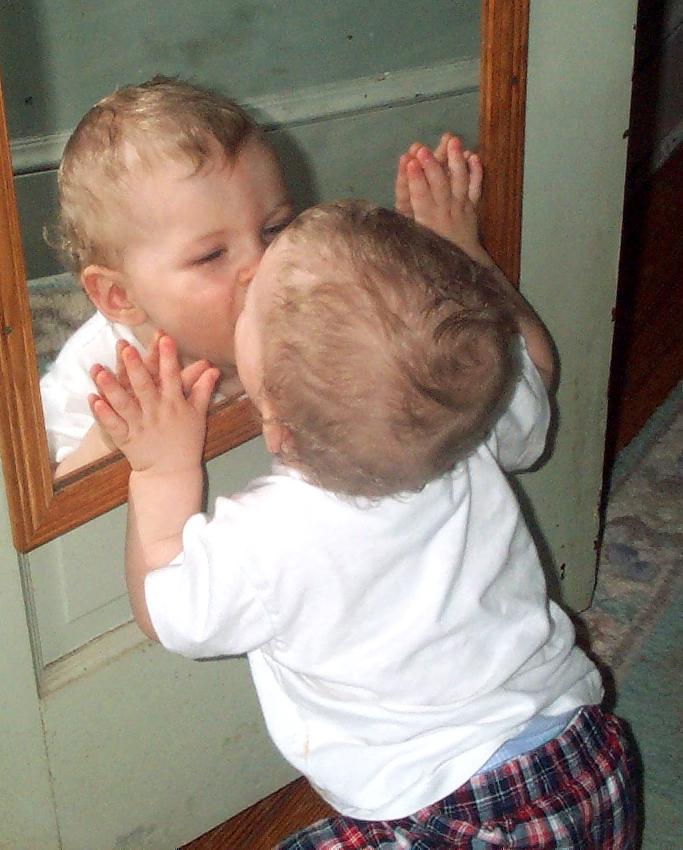5.6 Self-Awareness and Consciousness
One important aspect of cognition that should be addressed is self-awareness. Comprised of two components, consciousness and sentience, self-awareness can be operationalized and tested. The most common test is the Mirror Self Recognition Test (MSR). The MSR is comprised of five stages, with each stage aligning with a degree of self-awareness.
- Stage One: Social Behavior – In this stage, the research participant interacts with the image in the mirror as if it is another animal. They may growl at, attempt to play with, or otherwise try to engage with the reflection as a separate being. This suggests an awareness that there is a distinction between self and others.
- Stage Two: Exploratory Behavior – In this stage, the research participant looks behind the mirror, as if in attempt to find more animals with whom to engage. They may run around the mirror, look above or below, or otherwise attempt to see behind it. This suggests an awareness that the individual in the mirror may or may not actually be present, as well as an effort to problem solve who is in the reflection.
- Stage Three: Contingency Testing – In this stage, the research participant begins to test whether visual information in the mirror matches their own motor behavior. This might involve watching one’s hand or facial expression, head tilting, and other signs of curiosity. This suggests an awareness that the mirror is somehow copying them or otherwise representing their own actions.
- Stage Four: Self-Directed Behavior and Self-Inspection – In this stage, the research participant begins to use the mirror to examine themselves. They may poke at their eyes or teeth, make faces, or fuss with feathers or hair. This stage suggests an awareness that the individual in the mirror is actually them.
- Stage Five: The Mark Test – In this final stage, an odorless but visible mark is placed on the research participant. This may be in the form of a dot of paint or small sticker. In the event that the research participant returns to the mirror to investigate the place where the mark was left, especially if they attempt to use the mirror to remove it, they are said to be self-aware and fully conscious beings.

When comparing taxa on the MSR, it is important to note that humans do not pass the test until approximately 2 years of age. As demonstrated by the image above, toddlers primarily interact with their reflection as a social other. However, there are other species that pass, suggesting that we are not alone in the conscious thought world.
To date, the following animals have passed the MSR:
- Asian Elephants
- The Great Apes
- Bottlenose Dolphins
- Orca Whales
- Eurasian Magpies
- Rhesus Macaques
- Cleaner Wrasses
There is also evidence to suggest the following species may soon join this list:
In the case of some species, for example Rhesus Macaques, some initial teaching was required to pass the mirror test. Likewise, the evidence for cleaner wrasses and ants has sparked a debate about the validity of the test, raising many questions as to our current definition of consciousness.
MSR: A Biased Test?
One of the more interesting challenges to the MSR is that it is biased toward visually dominant species. To use a mirror, whether spontaneously or through learning, an individual must prioritize vision as a form of investigation. So, what about species where this is not the case?
Canine cognition researcher and author, Alexandra Horowitz, posed this very question for dogs. In her book Inside of a Dog, Horowitz unpacks the importance of umwelt when studying other animals. When using the mirror test, we are prioritizing a visual umwelt. Yet many species, including dogs, perceive the world very differently.
In 2017, Horowitz attempted to modify the MSR for dogs – a scent-oriented species. In the paper, she argues that dogs are not likely to use a mirror simply because vision is not the primary way they recognize others. Instead, she set up a study to test canine self-awareness through scent. Horowitz provided dogs with three categories of odor – their own, that of other dogs, and their own but altered. She found that dogs quickly passed over their own odor, distinguished between their odor and that of other dogs, and investigated their own, altered odor significantly longer than the others. With this evidence, Horowitz argues for a canine consciousness that can identify self, others, and understand when their “appearance” has been modified.
What does this mean for the future of cognition research? For one, it is clear we have much more to learn about the cognitive evolution of other species. In turn, we may find new ways to understand our own and that of our evolutionary ancestors.
refers to individual awareness of unique thoughts, memories, feelings, sensations, and environments.
having the capacity to have feelings and responses to one's environment; capable of sensing the world around oneself.
the world as it is experienced by a particular organism; may denote the primary sense of experience (e.g., smell, sight).

